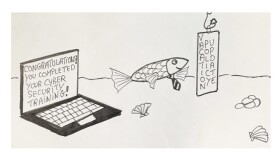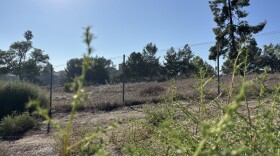The Golden Ray cargo ship was carrying more than 4,000 new cars when it capsized off the coast of Georgia last month. The crew survived, but the 656-foot ship is still there, lying half-submerged at about 90 degrees, on its side.
Despite lots of effort, it's been leaking an unknown amount of fuel and oil, which has local environmental advocates and commercial fishermen concerned. Oil has been found in sheens in the water, in bits on some beaches and in the marsh itself, indicated by black stains on the spartina grass.
Crews in yellow protective suits have been working 12 hours a day trying to mitigate the effects of the oil, setting up thousands of feet of containment boom, spraying sphagnum moss, a peat absorbent on the grass to keep it from sticking to other surfaces and animals, and removing already dead, oiled marsh grass.
They're part of what's known as Unified Command, a joint recovery and salvage effort between the state of Georgia, the Coast Guard and the shipping company, Hyundai Glovis's contractor, Gallagher Marine Systems. There are about 400 people and 70 vessels participating.
One of their top priorities has been pumping the roughly 300,000 gallons of fuel and oil out of the ship's tanks. They've gotten more than 220,000 gallons off so far.
"The vessel obviously is not designed to be on its side," said Commander Norm Witt, who is leading the Coast Guard's response to the wreck.
"So there are stresses on the hull. On a daily basis, more hourly basis experts are monitoring those stresses to see how it's impacting the vessel. As we pump out one tank, you're evaluating the next tank," he said.
But what's already spilled has become a big problem for fishermen like Scott Owens, a 20-year veteran charter boat captain in the area. He's had bookings cancel because of the Golden Ray and its leaks.
In early October, he was out fishing with clients and ran into bits of oil in the marsh.
"I thought [it] looked like burnt bark off a pine tree so I kept riding and didn't pay that much attention to it until I got up in the grass, and I saw it on blades of grass," he said.
Owens said seeing it made him mad.
"It really hit home because I was in my environment, looking at tailing redfish ... and there were egrets, there were pelicans, there were dolphins, there were manatees and they were all swimming right through this stuff. And it was everywhere," he said.
Owens and others have been going out to collect samples with scientists and environmental advocates — all volunteering their time.
"We have a lot of different contaminants," said Fletcher Sams, executive director of the local environmental group, Altamaha Riverkeeper. He's been out sampling and monitoring since the ship wrecked.
"From the anti-freeze in the radiators in the vehicles to the gasoline and the diesel in the vehicles, hydraulic fuel in the boat, heavy bunker fuel and marine gas oil. So you've got a mixture, a concoction of contaminants and each travels through the environment at different speeds."
"There's nothing on that ship that's coming off of it right now that's good," Owens said. "Except the fuel that people are taking off of there. That's about the only thing coming off that's good because it's not going in our water."
Owens and other fishermen like Greg Hildreth are worried about how this could affect their finances. Hildreth has a kid about to go to college.
"What's next year going to hold?" he asked. "What is this effect? What is it going to do? The not knowing is the scary thing about it."
There are many unanswered questions about the Golden Ray.
When will it be removed? How will they do it? The latest plan is to disassemble the ship in place because it is not strong enough to be safely righted and refloat.
However, the details of that plan are still up in the air. Salvage crews are rappelling and diving into more of the ship every day to try to assess the damage and structural health of the ship and figure that out. Each new part of the Golden Ray has to be tested for air and water toxicity before people can begin exploring it.
Sams said this removal plan makes his group particularly worried about the threat of further contamination from inside the cargo hold. "We will have to wait and see what plans they put into place to mitigate those impacts before we know for sure if our initial concerns are valid," he said.
Doug Haymans, director of coastal resources with the Georgia Department of Natural Resources, pointed out things could be a lot worse. "You know you never want something like this to happen," he said. "But for what it is we are very, very fortunate to this point. The amount of oil that we see to where it could be, we're very fortunate."
"The goal is to remove any potential threat to the environment," said Chris Graff, director of response services for Gallagher Marine Systems, which is representing the shipping company. "You won't be able to get all of it, we know that. There's always going to be some."
Copyright 2019 WABE 90.1. To see more, visit WABE 90.1.






